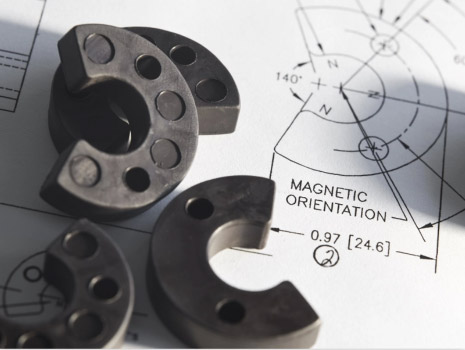
Magnet Glossary
Anisotropic Magnet: A magnet having a preferred direction of magnetic orientation, so that the magnetic characteristics are optimum in one preferred direction.
Coercive Force, Hc: The demagnetizing force, measured in Oersteds, necessary to reduce observed induction, B, to zero after the magnet has previously been brought to saturation.
Curie Temperature, Tc: The temperature at which the parallel alignment of elementary magnetic moments completely disappears, and the material is no longer able to hold magnetization.
Flux, ø: The condition existing in a medium subjected to a magnetizing force. This quantity is characterized by the fact that an electromotive force is induced in a conductor surrounding the flux at any time the flux changes in magnitude. The CGS unit of flux is the MAXWELL.
Gauss: Lines of magnetic flux per square centimeter, CGS
unit of flux density, equivalent to lines per square inch in the English system, and webers per square meter or Tesla in the SI system.
Hysteresis Loop: A closed curve obtained for a material by plotting corresponding values of magnetic induction, B, (on the abscissa) against magnetizing force, H, (on X axis, Y axis).
Induction, B: The magnetic flux per unit area of a section nor- mal to the direction of flux. Measured in Gauss, in the
CGS system of units.
Intrinsic Coercive Force, Hci: Measured in Oersteds in the CGS system, this is a measure of the material’s inherent ability to resist demagnetization. It is the demagnetization force corresponding to zero intrinsic induction in the magnetic material after saturation. Practical consequences of high Hci values are seen in greater temperature stability for a given class of mate- rial, and greater stability in dynamic operating conditions.
Irreversible Loss: Defined as the partial demagnetization of a magnet caused by external fields or other factors. These losses are only recoverable by re-magnetization. Magnets can be stabilized to prevent the variation of performance caused by irreversible losses.
Isotropic Magnet: A magnet material whose magnetic proper- ties are the same in any direction, and which can therefore be magnetized in any direction without loss of magnetic characteristics.
Leakage Flux: That portion of the magnetic flux that is lost through leakage in the magnetic circuit due to saturation or air-gaps, and is therefore unable to be used.
Magnetizing Force, H: The magnetomotive force per unit length at any point in a magnetic circuit. Measured in Oersteds in the CGS system.
Maximum Energy Product, BHmax: The point on the Demagnetization Curve where the product of B and H is a maximum and the required volume of magnet material required to project a given energy into its surroundings is a minimum. Measured in Mega Gauss Oersteds, MGOe.
North Pole: That pole of a magnet which, when freely suspended, would point to the north magnetic pole of the earth. The definition of polarity can be a confusing issue, and it is often best to clarify by using “north seeking pole” instead of “north pole” in specifications.
Oersted, Oe: A CGS unit of measure used to describe magnetizing force. The English system equivalent is Ampere Turns per Inch, and the SI system’s is Ampere Turns per Meter.
Orientation Direction: The direction in which an anisotropic magnet should be magnetized in order to achieve optimum magnetic properties. Also known as the “axis”, “easy axis”, or “angle of inclination”.
Residual Induction, Br: This is the point at which the hysteresis loop crosses the B axis at zero magnetizing force, and represents the maximum flux output from the given magnet material. By definition, this point occurs at zero air gap, and therefore cannot be seen in practical use of magnet materials.
Saturation: The condition under which all elementary magnetic moments have become oriented in one direction. A ferromagnetic material is saturated when an increase in the applied magnetizing force produces no increase in induction. Saturation flux densities for steels are in the range of 16,000 to 20,000 Gauss.
Stabilization: Exposure of a magnet to demagnetizing influences expected to be encountered in use in order to prevent irreversible losses during actual operation. Demagnetizing influences can be caused by high or low temperatures, or by external magnetic fields.
Permeance Coefficient, Pc: Ratio of the magnetic induction, Bd, to its self demagnetizing force, Hd. Pc = Bd/Hd. This is also known as the “load line” or operating point of the magnet and is useful in estimating the flux output of the magnet in various con- ditions. As a first order approximation, Bd.Hd = Lm/Lg, where Lm is the length of the magnet and Lg is the length of an air gap that the magnet is subjected to. Pc is therefore a function of the geometry of the magnetic circuit.
Pole Pieces: Ferromagnetic materials placed on magnetic poles used to shape and alter the effect of the lines of flux.
Saturation: The condition under which all elementary magnetic moments have become oriented in one direction. A ferromagnetic material is saturated when an increase in the applied magnetizing force produces no increase in induction. Saturation flux densities for steel are in a range of 16,000 to 20,000 Gauss.
Stabilization: Exposure of a magnet to demagnetizing influences expected to be encountered in use in order to prevent irreversible losses during actual operation. Demagnetizing influences can be caused by high or low temperatures, or by external magnetic fields.





